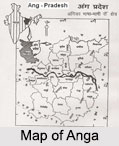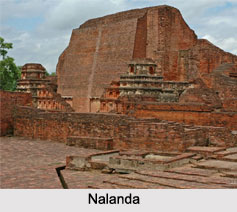 Ancient East Indian Cities were evolved after having trading route with China and South East Asia. In Mahabharata, the east India was ruled by King Karna of Kauravas. After that, the Bengal (now West Bengal and independent Bangladesh), Bihar and Odisha was ruled by Nanda Dynasty, Mahameghavahana dynasty, Maurya Empire, Kharavela, Sunga Dynasty, Kalinga Dynasty, Eastern Ganga dynasty, Shishunaga dynasty, Gupta Empire and Pala Dynasty. Later, it was incorporated to Delhi Sultanates, Mughal Dynasty and Maratha Empire in the medieval era. When Maurya Empire was established and later reconstructed by Emperor Ashoka, the East Indian cities became the seat of Buddhism cult and literature. Jainism was also spread there. The Emperor of Kalinga, Mahameghavahana Aira Kharavela was one of the most powerful monarchs of ancient India. It is described in the Hathigumpha Inscription, Kharvela was a Dravidian origin and he was the worshipper of all the religions. In education, the cities of ancient Nalanda, Puphagiri and Vikramshila universities were the famed institutions of higher learning in ancient India located in Eastern India.
Ancient East Indian Cities were evolved after having trading route with China and South East Asia. In Mahabharata, the east India was ruled by King Karna of Kauravas. After that, the Bengal (now West Bengal and independent Bangladesh), Bihar and Odisha was ruled by Nanda Dynasty, Mahameghavahana dynasty, Maurya Empire, Kharavela, Sunga Dynasty, Kalinga Dynasty, Eastern Ganga dynasty, Shishunaga dynasty, Gupta Empire and Pala Dynasty. Later, it was incorporated to Delhi Sultanates, Mughal Dynasty and Maratha Empire in the medieval era. When Maurya Empire was established and later reconstructed by Emperor Ashoka, the East Indian cities became the seat of Buddhism cult and literature. Jainism was also spread there. The Emperor of Kalinga, Mahameghavahana Aira Kharavela was one of the most powerful monarchs of ancient India. It is described in the Hathigumpha Inscription, Kharvela was a Dravidian origin and he was the worshipper of all the religions. In education, the cities of ancient Nalanda, Puphagiri and Vikramshila universities were the famed institutions of higher learning in ancient India located in Eastern India.
Anga
Anga was an early Hindu kingdom that flourished on the eastern Indian states from C. 12th to 6th century BC. Later, it was annexed by the kingdom of Magadha in the same century. Anga also finds mention in the Jain Vyakhyaprajnapti"s list of ancient janapadas. The capital of Anga was Champa. According to Mahabharata and Harivamsa, Champa was formerly known as Malini. Champa was located on the right bank of river Ganges near its junction with river Champa. It was a very flourishing city and is referred to as one of six principal cities of ancient India.
Tamralipta
Tamralipta was the name of an ancient city on the Bay of Bengal. It is believed by scholars that the ancient Tamralipta was the site of Tamluk in Midnapore District.
Rajgir
Rajgir is a very scenic place in Bihar. It is a small hill town, covered with lush green forest which adds to the beauty of the place. Rajgir was the capital of the Magadha, when Patliputra was not formed.
Chandraketugarh
Chandraketugarh is an archaeological site located beside the Bidyadhari River which is near the township of Berachampa and the Haroa Road railhead.
Devkota
Devkota was an ancient city which was the administrative centre of Kotivarsha Vishaya in the period of Chandra Dynasty, Varman Dynasty and Sena Dynasty.
Nalanda
Nalanda, now in Bihar is located about 95 kilometers southeast of Patna near the town of Bihar Sharif.
Pataliputra
Pataliputra is a city in ancient India. It was originally built by Magadha ruler Ajatashatru in 490 BC as a small fort near the banks of Ganga River.
Rajapura
Rajapura, which is now in Odisha, was the capital of Kalinga king Chitrangada in the Mahabharata era. The wife of Duryodhana was the daughter of Chitrangada.



















